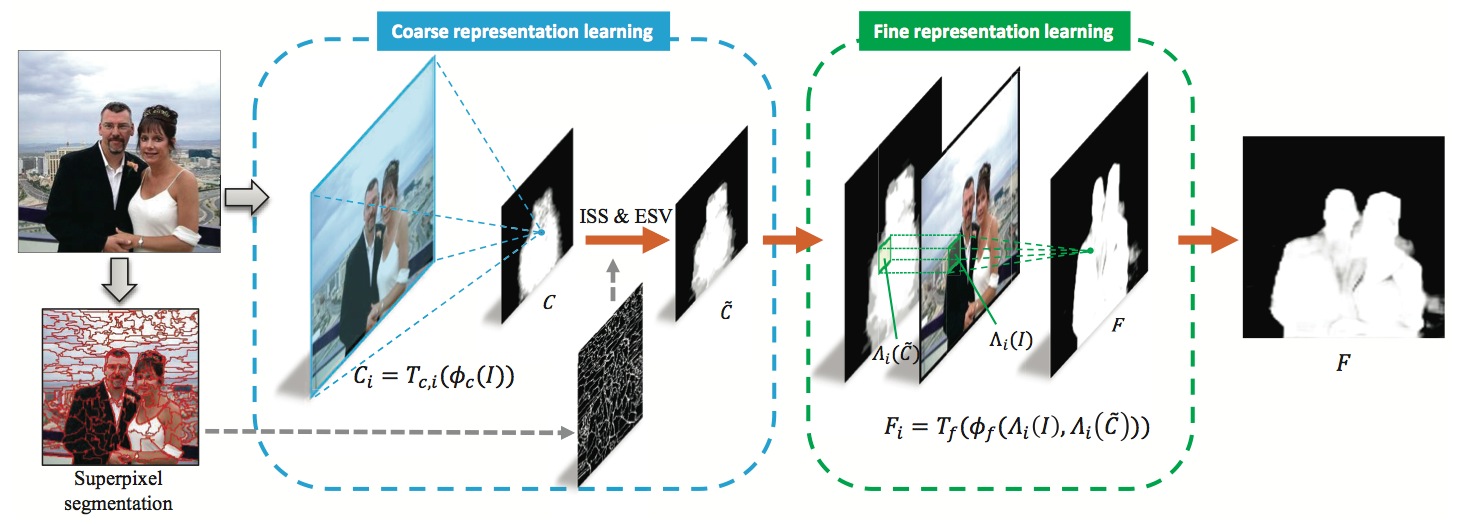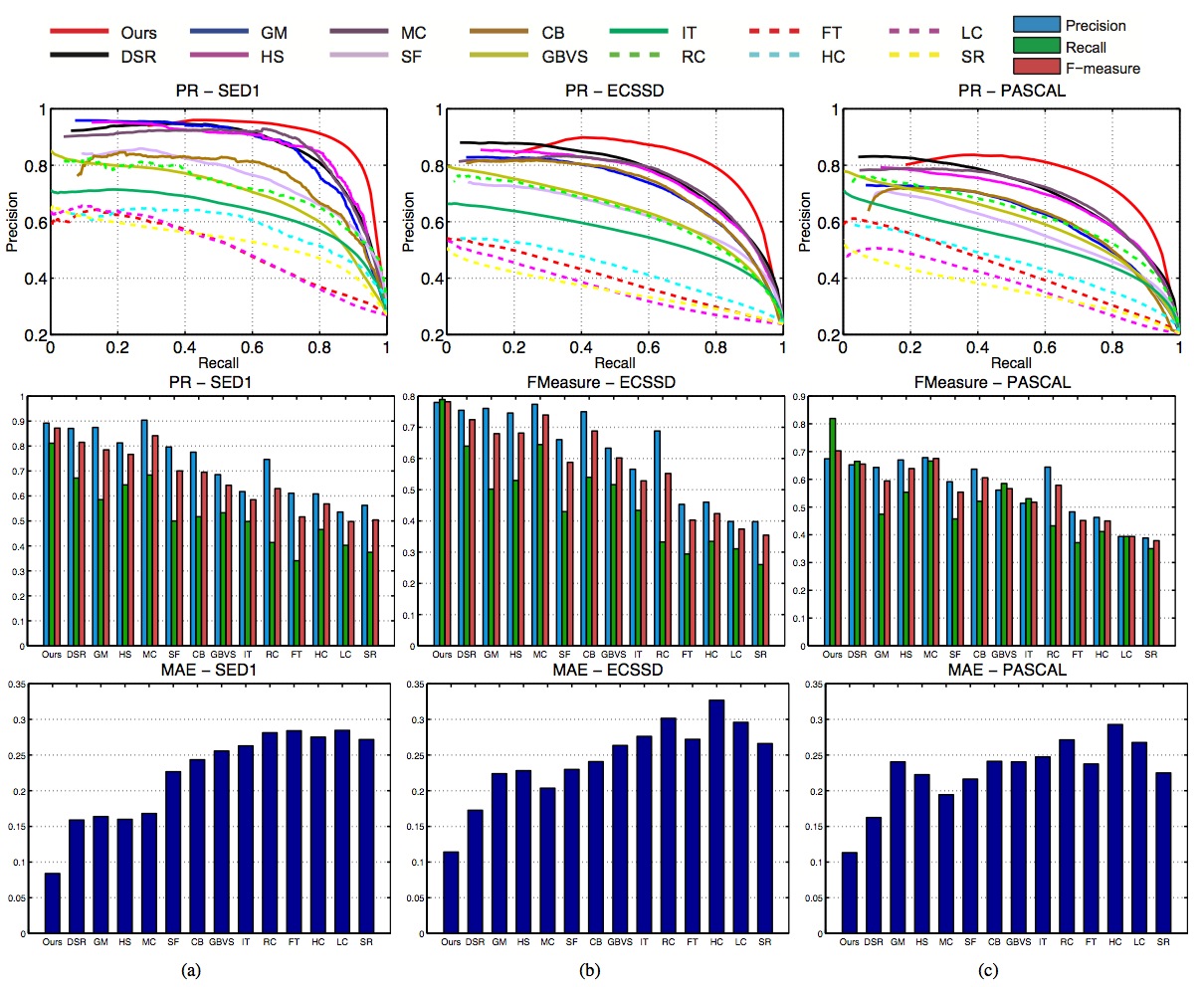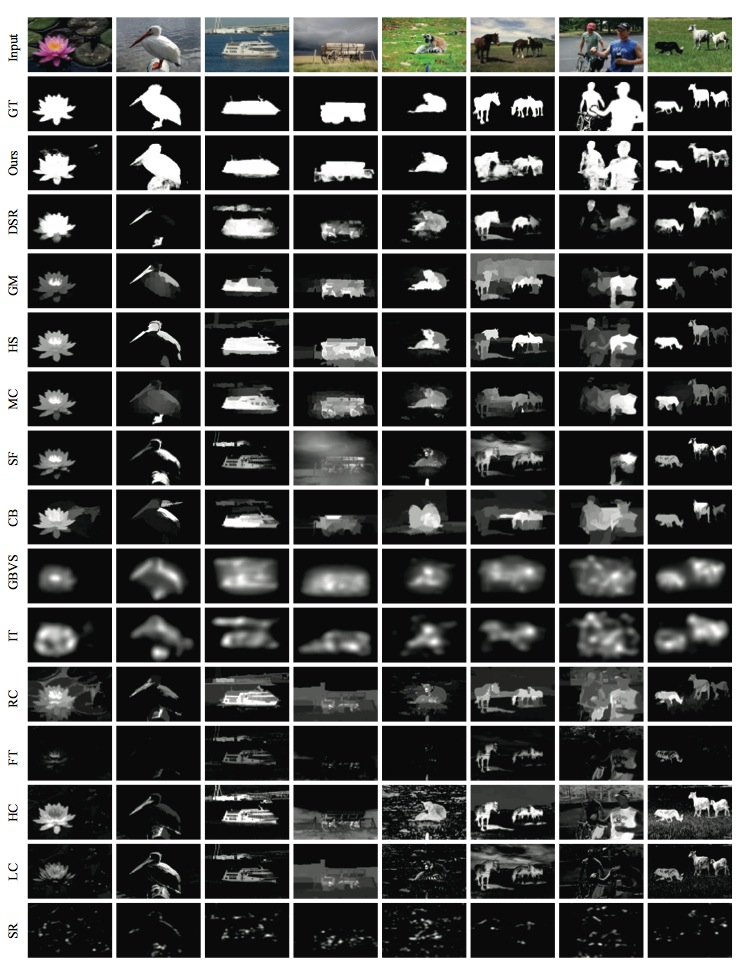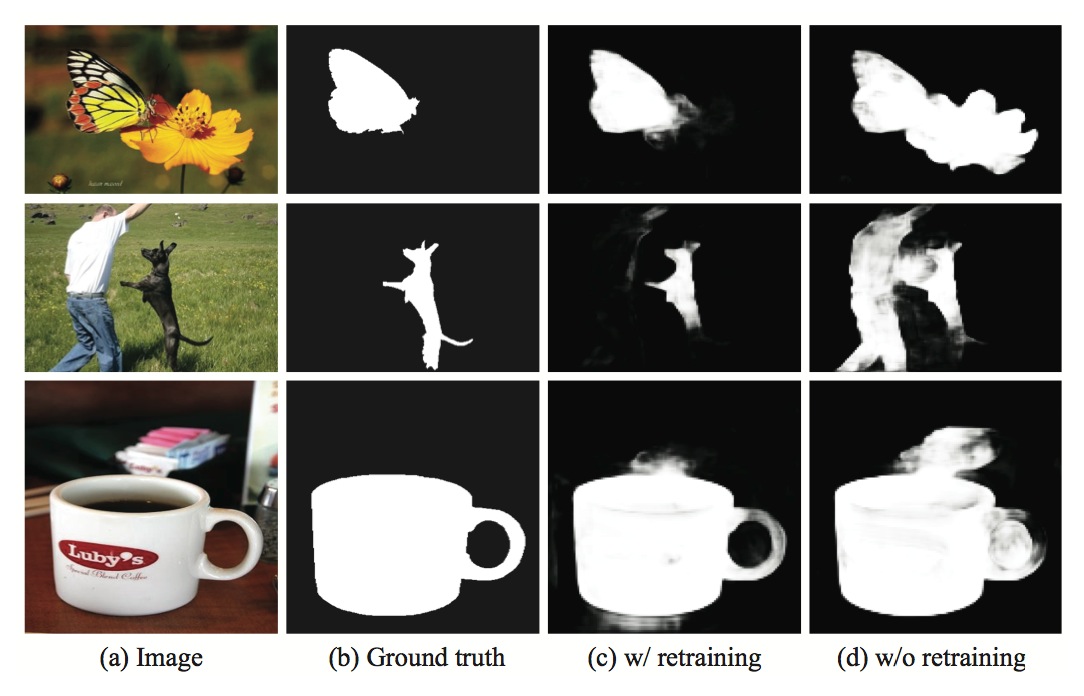Deep Image Saliency Computing
Paper
- Tianshui Chen, Liang Lin*, Lingbo Liu, Xiaonan Luo, and Xuelong Li, “DISC: Deep Image Saliency Computing via Progressive Representation Learning”, IEEE Transactions on Neural Networks and Learning Systems (T-NNLS), DOI: 10.1109/TNNLS.2015.2506664, 2015.PDF
Architecture

Fig. Illustration of our proposed deep saliency computing model. The first CNN takes the whole image data as input and produces coarse map. Guided by the coarse map, the second CNN takes a local patch as input and generates the fine-grained saliency map.
Quantitative Comparisons

Fig. Experimental results on the MSRA10K dataset. (a) Precision-recall curve, (b) precision-recall bar with F-measure, and (c) mean absolute error for comparing our model against previous works.

Fig. Experimental results on the (a) SED1, (b) ECSSD, and (c) PASCAL1500 datasets compared with previous works. Precision-recall curves (the first row), precision-recall bar with F-measure (the second row), and mean absolute error (the third row) show superior generalization ability of our proposed method. Note that our method still achieves state-of-the-art performance even though the model is learned on MSRA10K without fine-tuning to the target datasets.

Fig. The Precision-Recall with F-measure, MEA and Running Time of DISC and other three CNN-base methods on SED1 dataset.
Visual Comparisons

Fig. Visual comparision with previous methods. The images are taken from MSRA10K (first two columns), SED1 (third and fourth columns), ECSSD (fifth and sixth columns), and PASCAL1500 (last two columms). Our results not only highlight the overall objects but preserve boundary and structure details.
Task-Oriented Adaptation

Fig. The result of task-oriented salient object detection without and with retraining. All the salient objects are highlighted in (d), but only the specific object is highlighted after retraining in (c).
Downloads
DISC Source Code: DISC Source Code.
DISC_Image_Result_Map: DISC_Image_Result_Map.
References
- DSR –X. Li, H. Lu, L. Zhang, X. Ruan, and M.-H. Yang, “Saliency detection via dense and sparse reconstruction,” in Proc. IEEE Int. Conf. Comput.Vis., Sydney, Australia, Dec. 2013, pp. 2976–2983.
- GM – C. Yang, L. Zhang, H. Lu, X. Ruan, and M.-H. Yang, “Saliency detection via graph-based manifold ranking,” in Proc. IEEE Conf. Comput. Vis. Pattern Recognit., Portland, OR, USA, Jun. 2013, pp. 3166–3173.
- HS, ECSSD – Q. Yan, L. Xu, J. Shi, and J. Jia, “Hierarchical saliency detection,” in Proc. IEEE Conf. Comput. Vis. Pattern Recognit., Portland, OR, USA, Jun. 2013, pp. 1155–1162.
- MC – B. Jiang, L. Zhang, H. Lu, C. Yang, and M.-H. Yang, “Saliency detection via absorbing markov chain,” in Proc. IEEE Int. Conf. Comput. Vis., Sydney, Australia, Dec. 2013, pp. 1665–1672.
- SF –F. Perazzi, P. Krahenbuhl, Y. Pritch, and A. Hornung, “Saliency filters: Contrast based filtering for salient region detection,” in Proc. IEEE Conf.
Comput. Vis. Pattern Recognit., Providence, RI, USA, Jun. 2012, pp.733–740. - CB – H. Jiang, J. Wang, Z. Yuan, T. Liu, N. Zheng, and S. Li, “Automatic salient object segmentation based on context and shape prior.” in Proc.Brit. Mach. Vis. Conf., Dundee, Britain, Aug./Sep. 2011, pp. 1–12.
- GBVS – J. Harel, C. Koch, and P. Perona, “Graph-based visual saliency,” in Proc.Adv. Neural Inf. Process. Syst., Vancouver, British Columbia, Canada, Dec. 2006, pp. 545–552.
- IT –L. Itti, C. Koch, and E. Niebur, “A model of saliency-based visual attention for rapid scene analysis,” IEEE Trans. Pattern Anal. Mach.Intell., vol. 20, pp. 1254–1259, Nov. 1998.
- RC, HC, MSRA10K – M.-M. Cheng, G.-X. Zhang, N. J. Mitra, X. Huang, and S.-M. Hu,“Global contrast based salient region detection,” in Proc. IEEE Conf. Comput. Vis. Pattern Recognit., Colorado Springs, CO, USA, Jun. 2011, pp. 409–416.
- FT – R. Achanta, S. Hemami, F. Estrada, and S. Susstrunk, “Frequency-tuned salient region detection,” in Proc. IEEE Conf. Comput. Vis. Pattern Recognit., Miami, FL, USA, Jun. 2009, pp. 1597–1604.
- LC – Y. Zhai and M. Shah, “Visual attention detection in video sequences using spatiotemporal cues,” in Proc. ACM Multimedia, Santa Barbara, CA, USA, Oct. 2006, pp. 815–824.
- SR – X. Hou, L. Zhang, “Saliency detection: A spectral residual approach,” in Proc. IEEE Conf. Comput. Vis. Pattern Recognit., Minneapolis, MN, USA, 2007, pp. 1–8
- SED1 – S. Alpert, M. Galun, R. Basri, and A. Brandt, “Image segmentation by probabilistic bottom-up aggregation and cue integration,” in Proc. IEEE Conf. Comput. Vis. Pattern Recognit., Minneapolis, MN, USA, 2007.
- PASCAL1500 – W. Zou, K. Kpalma, Z. Liu, and J. Ronsin, “Segmentation driven low-rank matrix recovery for saliency detection,” in Proc. Brit. Mach. Vis. Conf., Bristol, Britain, Sep. 2013, pp. 1–13.
- THUR15k – M.-M. Cheng, N. J. Mitra, X. Huang, and S.-M. Hu, “Salientshape: Group saliency in image collections,” The Visual Computer, vol. 30, no. 4, pp. 443–453, 2014.


